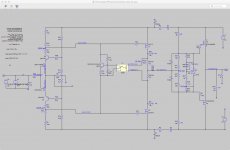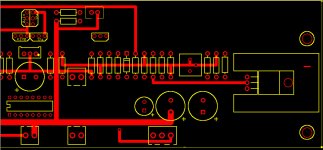I visited today again my friend Peter G. near Frankfurt.
As I told you some weeks ago, he has a good chain, Klipschorns and two Monoblocks 845 50W Master Sound from Italy and a very good pre from the same factory.
But we heard first my "Puck Beast running at home" version you can find in this thread.
Sound was a bit dark and a bit too soft.
So I asked him for two DMM, he had only one, but nevertheless we trimmed the bias of the second stage from 36mA to 42mA.
Incredible what these 6mA made a difference!
Punch, attack and dynamics, a bit too much, so we went back to 38mA .
Now the things were in the right order, attack and musicality ....
Because it was a quick adjustment the driver bias got higher after 15 minutes again and you could hear that.
So careful and lengthy adjustment fitting to the speaker you drive is a must!
So the difference between the two amps was very easy.....
The puck beast made a much greater room, was slamming details, bass an guitar passages in the room with great clarity and attack and the separation of different instruments was very good.
The room the Mastersound produced was narrower, the bass had less slam, the medium area and the highs were more coherent and the whole atmosphere was brighter and very nice too!
We both agreed that the Puck Beast is nevertheless astonishing as a DIY amp.
We all know that Nelson hears his amps a long time and fine tunes everything.
So the XA25 is for sure better.....
Nevertheless.... it is a pleasure to build a beast!
Next thing I will do, I will finish and hear this circuit, done by Peter (pr) for me.
http://www.diyaudio.com/forums/pass-labs/300233-f4-beast-builders-81.html#post4996543
Here exists no degeneration in all three stages.
Of course the regulation ist not the one Nelson uses. It is only done for the second stage with an optocoupler to avoid running away.
It behaves good in Spice and I hope same in reality.
One step further.... :--))
As I told you some weeks ago, he has a good chain, Klipschorns and two Monoblocks 845 50W Master Sound from Italy and a very good pre from the same factory.
But we heard first my "Puck Beast running at home" version you can find in this thread.
Sound was a bit dark and a bit too soft.
So I asked him for two DMM, he had only one, but nevertheless we trimmed the bias of the second stage from 36mA to 42mA.
Incredible what these 6mA made a difference!
Punch, attack and dynamics, a bit too much, so we went back to 38mA .
Now the things were in the right order, attack and musicality ....
Because it was a quick adjustment the driver bias got higher after 15 minutes again and you could hear that.
So careful and lengthy adjustment fitting to the speaker you drive is a must!
So the difference between the two amps was very easy.....
The puck beast made a much greater room, was slamming details, bass an guitar passages in the room with great clarity and attack and the separation of different instruments was very good.
The room the Mastersound produced was narrower, the bass had less slam, the medium area and the highs were more coherent and the whole atmosphere was brighter and very nice too!
We both agreed that the Puck Beast is nevertheless astonishing as a DIY amp.
We all know that Nelson hears his amps a long time and fine tunes everything.
So the XA25 is for sure better.....
Nevertheless.... it is a pleasure to build a beast!
Next thing I will do, I will finish and hear this circuit, done by Peter (pr) for me.
http://www.diyaudio.com/forums/pass-labs/300233-f4-beast-builders-81.html#post4996543
Here exists no degeneration in all three stages.
Of course the regulation ist not the one Nelson uses. It is only done for the second stage with an optocoupler to avoid running away.
It behaves good in Spice and I hope same in reality.
One step further.... :--))
Attachments
Generg, when you build sch. in post #983 try using 100R/10R in feedback loop instead of 2k/200R (R45/R5) and listen to difference.
10R should be 1W or so and 100 R can be made of 3 x 330R/2-3W paralleled ( it's close enough).
10R should be 1W or so and 100 R can be made of 3 x 330R/2-3W paralleled ( it's close enough).
Hi Juma,
😱😱so low...😱😱
that will give more than 6odB OLG.
and maybe 40dB of feedback.....
But why not I will do it!
😀
😱😱so low...😱😱
that will give more than 6odB OLG.
and maybe 40dB of feedback.....
But why not I will do it!
😀
... 😱😱so low...😱😱
that will give more than 6odB OLG....
Luckily, it doesn't work that way... 😀
The point is, when you use so called "current feedback" (I'd rather call it low impedance node feedback) you shouldn't impede it with high resistance...
Anyway, it's easy to try...
feedback goes over three stages.....
I can't remember the exact figure in mine, but it might have been 40dB local and 15dB global.
Have you removed local cascode feedback?
That is (almost) exactly what I am doing. My simulations show that the amplifier is capable of rather high class-AB power levels, so with that in mind, what is the necessary wattage of the 100R feedback resistor? I solve the high open-loop gain problem by loading the FE output at around 390R rather than using cascode feedback.Generg, when you build sch. in post #983 try using 100R/10R in feedback loop instead of 2k/200R (R45/R5) and listen to difference.
10R should be 1W or so and 100 R can be made of 3 x 330R/2-3W paralleled ( it's close enough).
Last edited:
Peak output voltage squared, divided by 100, times 2 (or 3 if you listen at the verge of clipping all the time)
The Watts calculation is not the issue. The real question is whether we should consider anything higher than 20V peak at the output, since the rail voltages might allow considerably more class-AB output.
The Watts calculation is not the issue. The real question is whether we should consider anything higher than 20V peak at the output, since the rail voltages might allow considerably more class-AB output.
Its DC amplifier. It should survive DC output voltage sticked to rail.
Its DC amplifier. It should survive DC output voltage sticked to rail.
The worst case for the feedback resistor would then be when there is no load on the amplifier output and a very high amplitude input.
...what is the necessary wattage of the 100R feedback resistor? ...
The Watts calculation is not the issue. ....
Make up your mind, mate ... 😀
Anyway, no matter what conditions you consider, Pd calculation from post #996 is still valid (with output sticking to rail speaker's health is of greater concern than feedback resistor's).
- Home
- Amplifiers
- Pass Labs
- F4 Beast Builders


